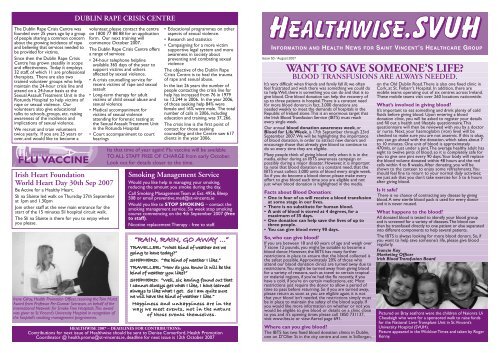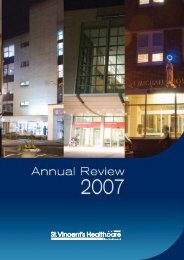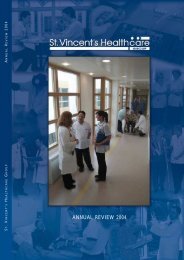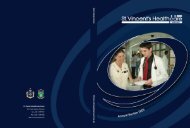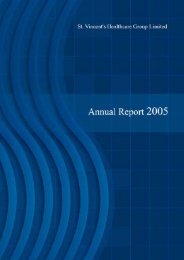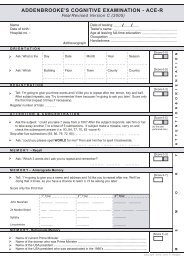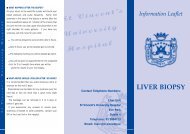Dublin Rape Crisis Centre - St Vincent's University Hospital
Dublin Rape Crisis Centre - St Vincent's University Hospital
Dublin Rape Crisis Centre - St Vincent's University Hospital
You also want an ePaper? Increase the reach of your titles
YUMPU automatically turns print PDFs into web optimized ePapers that Google loves.
DUBLIN RAPE CRISIS CENTRE<br />
The <strong>Dublin</strong> <strong>Rape</strong> <strong>Crisis</strong> <strong>Centre</strong> was<br />
founded over 25 years ago by a group<br />
of people sharing a common concern<br />
about the growing incidence of rape<br />
and believing that services needed to<br />
be provided for victims.<br />
Since then the <strong>Dublin</strong> <strong>Rape</strong> <strong>Crisis</strong><br />
<strong>Centre</strong> has grown steadily in scope<br />
and effectiveness. Today it employs<br />
32 staff, of which 11 are professional<br />
therapists. There are also two<br />
trained volunteer groups who help<br />
maintain the 24-hour crisis line and<br />
attend on a 24-hour basis at the<br />
Sexual Assault Treatment Unit in the<br />
Rotunda <strong>Hospital</strong> to help victims of<br />
rape or sexual violence. Our<br />
volunteers also give educational<br />
talks to schools, groups, etc. raising<br />
awareness of the incidence and<br />
implications of sexual violence.<br />
We recruit and train volunteers<br />
twice yearly. If you are 25 years or<br />
over, and would like to become a<br />
FLU VACCINE<br />
Irish Heart Foundation<br />
World Heart Day 30th Sep 2007<br />
Be Active for a Healthy Heart.<br />
Slí na Slainte led walk on Thursday 27th September<br />
at 1pm and 1.30pm<br />
Join other staff at the new main entrance for the<br />
start of the 15 minutes Slí hospital circuit walk.<br />
The Slí na Slainte is there for you to enjoy when<br />
you please.<br />
Irene Gilroy, Health Promotion Officer, receiving the Tom Hurst<br />
Award from Professor Per-Gunnar Svensson, on behalf of the<br />
International Network for Smoke Free <strong>Hospital</strong>s.This award<br />
was given to <strong>St</strong>.Vincent’s <strong>University</strong> <strong>Hospital</strong> in recognition of<br />
the hospital’s smoking management programmes.<br />
volunteer, please contact the centre<br />
on 1800 77 88 88 for an application<br />
form. Our next training will<br />
commence October 2007.<br />
The <strong>Dublin</strong> <strong>Rape</strong> <strong>Crisis</strong> <strong>Centre</strong> offers<br />
a range of services:<br />
• 24-hour telephone helpline<br />
available 365 days of the year to<br />
support victims and others<br />
affected by sexual violence.<br />
• A crisis counselling service for<br />
recent victims of rape and sexual<br />
assault<br />
• Long-term therapy for adult<br />
victims of child sexual abuse and<br />
sexual violence<br />
• Medical accompaniment for<br />
victims of sexual violence<br />
attending for forensic testing at<br />
the Sexual Assault Treatment Unit<br />
in the Rotunda <strong>Hospital</strong><br />
• Court accompaniment to court<br />
hearings<br />
• Educational programmes on other<br />
aspects of sexual violence.<br />
• Research and statistics<br />
• Campaigning for a more victim<br />
supportive legal system and more<br />
awareness in society about<br />
preventing and combating sexual<br />
violence<br />
The objective of the <strong>Dublin</strong> <strong>Rape</strong><br />
<strong>Crisis</strong> <strong>Centre</strong> is to heal the trauma<br />
of rape and sexual abuse.<br />
In the last 26 years the number of<br />
people contacting the crisis line for<br />
help has increased from 76 in 1979<br />
to 12,244 in 2006. In the year 2006,<br />
of those seeking help 84% were<br />
female and 16% were male. The total<br />
number of calls in 2006, including<br />
education and training, was 37, 266.<br />
The crisis line is the first point of<br />
contact for those seeking<br />
counselling and the <strong>Centre</strong> saw 617<br />
clients in the year 2006.<br />
Its that time of year again! Flu vaccine will be available<br />
TO ALL STAFF FREE OF CHARGE from early October.<br />
Look out for details closer to the time.<br />
Smoking Management Service<br />
Would you like help in managing your smoking,<br />
reducing the amount you smoke during the day.<br />
Call Smoking Management Team at Ext. 4956, Bleep<br />
508 or email preventive.med@st-vincents.ie<br />
Would you like to STOP SMOKING – contact the<br />
smoking management service. Six week stop smoking<br />
course commencing on the 4th September 2007 (free<br />
to staff).<br />
Nicotine replacement Therapy - free to staff.<br />
“RAIN, RAIN, GO AWAY …”<br />
TRAVELLER: “What kind of weather are we<br />
going to have today?”<br />
SHEPHERD: “The kind of weather I like.”<br />
TRAVELLER: “How do you know it will be the<br />
kind of weather you like?”<br />
SHEPHERD: “Well, sir, having found out that<br />
I cannot always get what I like, I have learned<br />
always to like what I get. So I am quite sure<br />
we will have the kind of weather I like.”<br />
Happiness and unhappiness are in the<br />
way we meet events, not in the nature<br />
of those events themselves.<br />
HEALTHWISE 2007 – DEADLINES FOR CONTRIBUTIONS:<br />
Contributions for next issue of Healthwise should be sent to Denise Comerford, Health Promotion<br />
Coordinator @ health.promo@st-vincents.ie, deadline for next issue is 12th October 2007<br />
INFORMATION AND HEALTH NEWS FOR SAINT VINCENT’S HEALTHCARE GROUP<br />
Issue 50 / August 2007<br />
WANT TO SAVE SOMEONE’S LIFE?<br />
BLOOD TRANSFUSIONS ARE ALWAYS NEEDED.<br />
It’s very difficult when friends and family fall ill; we often<br />
feel frustrated and wish there was something we could do<br />
to help.Well, there is something you can do and that is to<br />
give blood. One blood donation can help the recovery of<br />
up to three patients in hospital.There is a constant need<br />
for more blood donors; in fact, 3,000 donations are<br />
needed weekly to meet the demands of hospitals in the<br />
Republic of Ireland alone.This is an enormous target that<br />
the Irish Blood Transfusion Service (IBTS) must reach<br />
every single week.<br />
Our annual blood donation awareness week,or<br />
Blood for Life Week, is 17th September through 23rd<br />
September 2007.We will be highlighting the importance<br />
of blood donation, in order to attract new donors and<br />
encourage those that already give blood to continue to<br />
do so every time they are eligible.<br />
Many people think of giving blood only when it is in the<br />
media, either during an IBTS awareness campaign or<br />
possibly during a major disaster. However, it is important<br />
to note that blood donation is a constant need, that the<br />
IBTS must collect 3,000 units of blood every single week.<br />
So if you do become a blood donor, please make every<br />
effort to give blood each time you are eligible and not<br />
just when blood donation is highlighted in the media.<br />
Facts about Blood Donation:<br />
• One in four of us will receive a blood transfusion<br />
at some stage in our lives.<br />
• There is no substitute for human blood.<br />
• A unit of blood is stored at 4 degrees, for a<br />
maximum of 35 days.<br />
• One donation can help save the lives of up to<br />
three people.<br />
• You can give blood every 90 days.<br />
So, who can give blood?<br />
If you are between 18 and 60 years of age and weigh over<br />
7 stone 12 pounds, you might be suitable to become a<br />
blood donor. However, the IBTS has many further<br />
restrictions in place to ensure that the blood collected is<br />
the safest possible.Approximately 20% of those who<br />
attend our blood donation clinics are turned away due to<br />
restrictions.You might be turned away from giving blood<br />
for a variety of reasons, such as travel to certain tropical<br />
or malarial regions, if you’ve had the flu recently, if you<br />
have a cold, if you’re on certain medications, etc. Most<br />
restrictions just require the donor to allow a period of<br />
time to pass before returning. So if you are turned away,<br />
please return as soon as you are eligible again; it is not<br />
that your blood isn’t needed, the restrictions simply must<br />
be in place to maintain the safety of the blood supply. If<br />
you would like more information on whether or not you<br />
would be eligible to give blood or details on a clinic close<br />
to you and it’s opening times please call 1850 731137,<br />
visit www.ibts.ie or view Aertel page 691.<br />
Where can you give blood?<br />
The IBTS has two fixed blood donation clinics in <strong>Dublin</strong>,<br />
one on D’Olier <strong>St</strong> in the city centre and one in <strong>St</strong>illorgan,<br />
on the Old <strong>Dublin</strong> Road.There is also one fixed clinic in<br />
Cork, at <strong>St</strong>. Finbarr’s <strong>Hospital</strong>. In addition, there are<br />
mobile teams operating out of six centres across Ireland.<br />
These mobile teams visit over 260 locations nationwide.<br />
What’s involved in giving blood?<br />
It’s important to eat something and drink plenty of cold<br />
fluids before giving blood. Upon entering a blood<br />
donation clinic, you will be asked to register your details<br />
and fill out a health and lifestyle questionnaire.This<br />
questionnaire will then be reviewed with you by a doctor<br />
or nurse. Next, your haemoglobin (iron) level will be<br />
checked to make sure you are not anaemic. If this is okay,<br />
you can go ahead with the donation, which takes about 7<br />
to 10 minutes. One unit of blood is approximately<br />
470mls, or just under a pint.The average healthy adult has<br />
eight to twelve pints of blood, so it is completely safe for<br />
you to give one pint every 90 days.Your body will replace<br />
the blood volume donated within 48 hours and the red<br />
cells within 4 to 8 weeks.After donating, you will be<br />
shown to the canteen to enjoy some refreshments.You<br />
should feel fine to return to your normal daily activities;<br />
we just ask that you don’t take exercise for 5 to 6 hours<br />
after giving blood.<br />
Is it safe?<br />
There is no chance of contracting any disease by giving<br />
blood.A new sterile blood pack is used for every donor<br />
and it is never reused.<br />
What happens to the blood?<br />
All donated blood is tested to identify your blood group<br />
and is screened for a variety of diseases.The blood can<br />
then be transfused directly to one patient or else separated<br />
into different components to help several patients.<br />
The IBTS is always looking for more blood donors. So, if<br />
you want to help save someone’s life, please give blood<br />
regularly.<br />
Francie Kay<br />
Marketing Officer<br />
Irish Blood Transfusion Board<br />
Pictured on Bray seafront were the children of Naionra Ui<br />
Cheadaigh who went for a sponsored walk to raise funds<br />
for the National Liver Transplant Unit in <strong>St</strong>.Vincent’s<br />
<strong>University</strong> <strong>Hospital</strong> (SVUH).<br />
Picture appeared in the Wicklow Times and taken by Roger<br />
Kenny.
HEALTHY EATING/ACTIVE LIVING IN SVUH (H.E.A.L)<br />
HOSPITAL CHALLENGE DAY<br />
Launch of Slí na Sláinte for SVUH<br />
The Irish Heart Foundation (IHF) Slí na Sláinte was<br />
launched by Mr. Eamon Coghlan, FOUR time Olympian<br />
runner on <strong>Hospital</strong> Challenge Day, 17th May 2007.The Slí<br />
is a circuit 1.2km circumference walk around the hospital.<br />
Mr. Gary O’Toole, Orthopaedic Surgeon and Chairman<br />
of the Health Promotion Committee (SVUH) acted as<br />
Master of Ceremonies for the event.<br />
Mr. Michael O’Shea, Director of the Irish Heart<br />
Foundation (IHF) gave a short address, highlighting that<br />
by making walking an available, attractive choice within<br />
and around the hospital, the daily 30 minutes of physical<br />
activity recommendation will be easier to achieve.<br />
Mr. Cormac Maloney, Deputy CEO, SVUH, welcomed<br />
the addition to the hospital and congratulated the<br />
Department of Preventive Medicine & Health<br />
Promotion on their ongoing commitment to making the<br />
hospital a supportive environment for healthy living for<br />
both staff and patients.<br />
In the week leading up to the event, departments in the<br />
hospital were asked to nominate a representative to<br />
co-ordinate the event at department level.Twenty three<br />
representatives participated.The role of the<br />
representative was to promote <strong>Hospital</strong> Challenge Day<br />
in their department and to get as many staff as possible<br />
to sign a pledge to take 15 minutes physical activity on<br />
the day. Each representative was entered into a draw.<br />
Mr. Paul Gough, Dietitian, and member of the Health<br />
Promotion Committee was the winner of a €50<br />
voucher for “Lifestyle Sports”.<br />
In total 736 people signed up to do 15 minutes physical<br />
activity on the day. Each person who signed up was<br />
entered into a draw. Ms. Helen Costigan, Intensive Care<br />
Unit, was the winner of a €50 voucher for “Lifestyle<br />
Sports”.<br />
The DART Challenge<br />
The Slí na Sláinte is complimented by “Time to Walk”<br />
signs e.g. how long it takes to walk to “Sydney Parade”<br />
DART station from SVUH.The Irish Heart Foundation<br />
gave a conservative time of 9 minutes.<br />
We wanted to see how long it actually took SVUH staff<br />
to walk this route. Between 7:00am and 9:00am on<br />
Thursday 17th May, a team from the Department of<br />
Preventive Medicine & Health Promotion were at the<br />
DART station to give questionnaires to hospital staff<br />
who took the DART to work.<br />
How long did it take our staff?<br />
Allowing for traffic light delays, the average length of<br />
time taken to walk from the “Sydney Parade” DART<br />
station to SVUH was 5 minutes.Times ranged between<br />
3 minutes and 10 minutes.<br />
JUST 15 MINUTES PHYSICAL ACTIVITY<br />
YOUR WAY EVERYDAY!<br />
WHAT HAPPENED ON THE DAY?<br />
All those who returned forms were entered into a<br />
draw for a €50 “Lifestyle Sports” voucher. The winner<br />
was Ms. Rosaleen McGuire Roche, Psychiatry<br />
Department.<br />
Guided Slí na Sláinte walks<br />
Two lunchtime walks were arranged. Over 50 staff<br />
members participated.This proved to be a great way of<br />
meeting and chatting with people from other<br />
departments. Sheridan’s Juice Bar kindly gave vouchers<br />
for free smoothies or juices for distribution to those<br />
who took part in the Slí walks.<br />
Sheridan’s Juice Bar also had an opening offer in<br />
conjunction with <strong>Hospital</strong> Challenge Day.They gave a 50%<br />
price reduction on all smoothies and juices on the day.<br />
Healthy Eating<br />
SVUH are applying for the healthy eating award<br />
from the Irish Heart Foundation – One of the<br />
requirements is that the hospital should offer<br />
a ‘No Chip Day’ each week.Thursday is now<br />
a ‘No Chip Day’ in the hospital. <strong>Hospital</strong><br />
Challenge Day was chosen as the launch<br />
day. Change can be difficult for people but<br />
staff are enjoying the many other choices on<br />
offer in the staff restaurant.<br />
The hospital Slí na Sláinte is there for<br />
hospital staff and visitors to enjoy anytime.<br />
A guided Slí na Slainte walk will take place on Thursday<br />
27th September. Meet at main hospital entrance at 1pm<br />
or 1.30pm to join others for a 15 minute walk.<br />
A collage outlining events of <strong>Hospital</strong> Challenge Day<br />
2007 created by Professor Cecily Kelleher, Department<br />
Head, Department Preventive Medicine/Health<br />
Promotion will be displayed in the new Ambulatory Day<br />
Care <strong>Centre</strong> building.<br />
OBESITY<br />
– the size of the problem<br />
Diabetes affects 300,000 people in Ireland, with<br />
100,000 of these currently undiagnosed.The vast<br />
majority of these patients have type 2 diabetes,<br />
and the numbers are predicted to double over the<br />
next 10 years due largely to the rising rates of<br />
obesity – the ‘diabesity epidemic’. In Ireland at the<br />
present time 39% of adults are overweight and<br />
18% are obese. Excess body weight is now the<br />
most prevalent childhood disease in Europe,<br />
affecting one in six children. It is estimated that<br />
there are more than 300,000 overweight and<br />
obese children on the island of Ireland and that<br />
this figure is rising yearly by 10,000.<br />
Obesity is responsible for up to 80% of type 2<br />
diabetes and is associated with the development<br />
of other medical conditions, such as non-alcoholic<br />
fatty liver disease (NAFLD) and cardiovascular<br />
disease. However, 20% of severely obese people<br />
have no evidence of abnormal glucose handling or<br />
NAFLD. Little is known about the factors that<br />
protect this group from the harmful metabolic<br />
consequences of obesity.<br />
Our research group aims to study fat tissue, liver<br />
biopsy samples, and immune blood cells from<br />
obese patients with and without diabetes, with a<br />
view to identifying some of the differences<br />
between them.<br />
We believe that fat cell size may be a key<br />
determinant of whether an obese individual<br />
develops type 2 diabetes and the other metabolic<br />
complications of obesity. Large fat cells may be<br />
dysfunctional and have an altered capacity to<br />
accommodate excess energy-intake.This could<br />
lead to an overflow of fat into other tissues, such<br />
as muscle and liver, eventually resulting in diabetes<br />
or NAFLD. In addition, obesity is associated with<br />
chronic low grade inflammation, which is also<br />
thought to contribute to diabetes and other<br />
obesity related co-morbidities.We are therefore<br />
also looking at the immune cells, both in the<br />
circulation and in the fat tissue to identify any<br />
differences between ‘healthy’ and ‘unhealthy’ obese<br />
patients.<br />
The tissue samples are obtained from some of the<br />
patients who undergo gastric bypass surgery in <strong>St</strong><br />
Columcille’s <strong>Hospital</strong>.This surgery is the only<br />
effective treatment for severe obesity, reducing<br />
mortality by up to 90%.The weight loss that<br />
follows surgery leads to an improvement in, or<br />
complete resolution of type 2 diabetes in 80% of<br />
patients.<br />
Having access to data and tissue from this patient<br />
group provides a unique opportunity to study the<br />
pathophysiology of type 2 diabetes, obesity and<br />
NAFLD in Ireland.<br />
Dr. Jean O’Connell,<br />
Clinical Scientist<br />
Obesity Research Group<br />
Education & Research <strong>Centre</strong><br />
GUIDE TO PACKING<br />
A HEALTHY LUNCH<br />
Introduction<br />
A packed lunch does not have to be a boring. With a<br />
little imagination and creativity they can be interesting,<br />
healthy and tasty too and something that can wet the<br />
appetite every lunchtime. Just try and include<br />
something from each of the four main food groups as<br />
well as a drink and you are ready to go.<br />
The Basics – breads, cereals, pasta or potatoes<br />
Use different types of bread eg. Rolls, slices, baguettes,<br />
bagels (the list is endless)<br />
Use a variety of breads too – wholemeal, granary,<br />
brown, high fibre white<br />
Or try basing your lunch on rice, pasta or potatoes<br />
instead eg. Pasta salad<br />
Add a Tasty Filling<br />
Try to include lean meat, chicken, fish, eggs, nuts, beans<br />
or pulses in your lunches as a protein source. Eg.<br />
Egg mayonnaise, peppers and cucumber<br />
Tuna and tomato<br />
Chicken Tikka and salad<br />
Ham cheese and tomato<br />
Handful of plain peanuts or sunflower seeds<br />
Use a low fat spread or salsa as an alternative<br />
Fruits and Vegetables<br />
It is important to eat 5 portions of fruit and vegetables<br />
every day. Try and include some of the following:<br />
Fresh fruit – apple, banana, orange, kiwi,<br />
nectarine, 6-8 strawberries etc<br />
Chopped raw vegetables – carrot sticks,<br />
cherry tomatoes, salad<br />
Tinned fruit in fruit juice<br />
Include some Dairy<br />
Try to include some dairy products to help<br />
maintain healthy teeth and bones<br />
Carton of semi-skimmed milk<br />
Low fat yoghurt<br />
Rice pudding<br />
Low fat cheese eg babybel x 2<br />
The Treat<br />
There is nothing wrong with including a treat. Just try<br />
and make a healthier choice when doing so<br />
Low fat crisps or pretzels<br />
Salted popcorn<br />
Cereal bar<br />
Fun sized bar of chocolate<br />
Include a Drink<br />
To help stay well hydrated choose from:<br />
Water, milk or milkshake, pure fruit juice, low sugar<br />
squash or diet drinks<br />
Remember to keep your lunch cool to keep it fresh.<br />
Enjoy!<br />
Thanks to Paul Gough, Dietitian, for this article.


